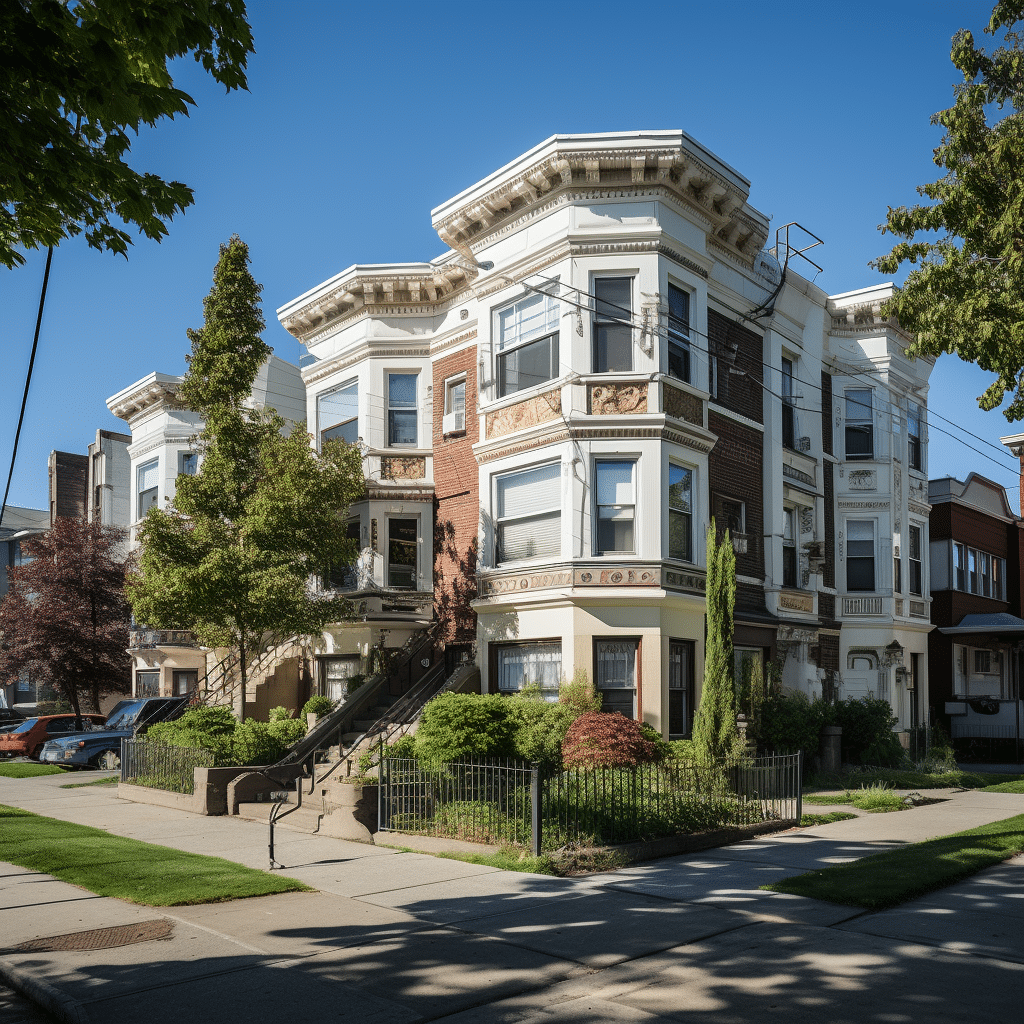As we sail into 2024, the lure of multifamily real estate for prospective investors seems irresistible. With the promise of stable cash flow and excellent potential for growth, ain’t it time you took the plunge? Here’s the scoop on how to make the most of multifamily opportunities in 2024.
The Lure of Multifamily for Sale in 2024
“Multifamily real estate” is a term that describes buildings with multiple units for residential tenants – think duplex buildings, 4 Plex properties, and large apartment complexes. While multifamily real estate may be a tad more challenging to get into compared to single-family homes, it provides an array of investment benefits, such as increased cash flow, risk diversification, and favorable loan terms.
It’s no secret that real estate investment, including multifamily real estate, is all about location. The accessibility to schools, shops, and other facilities can significantly affect the property’s value and attractiveness to potential tenants. In the whirlwind era of post-pandemic recovery, multifamily properties in strategic locations are worth their weight in gold.
Why 2024 is the Best Time to Invest in Multifamily Real Estate
According to industry experts, with the escalating housing needs and trends, 2024 might be prime time for multifamily investing. The ongoing urbanization leading to significant migration to cities and increased renting trends indicate a steady demand for multifamily units. What’s more, with the boom in remote working, there’s a clear shift towards preferring homes that offer more than just a place to sleep. This creates a significant opportunity for investors eyeing multifamily for sale, especially those with well-planned communal areas or home offices.

Multifamily Investment Risks You Should Be Aware Of
Before diving headfirst into the multifamily territory, consider the potential hazards. We ain’t painting a gloomy picture here just for the heck of it. It’s crucial to acknowledge the risks to devise a robust risk management strategy.
Risks Associated with Multifamily Investing
Top-off on the list is the potential challenge of managing multiple units and tenants. More tenants could equate to more complaints, more maintenance, and more responsibilities. Additionally, vacancies can have a significant impact on your overall cash flow, and high tenant turnover could become a severe pain in the neck.
Then, there’s market risk. Factors such as fluctuations in the economy, interest rates, and housing market trends can influence the multifamily property’s value.
Significant Upfront Capital Requirement for Multifamily Investments
Fancy a gourmet pizza without paying a few extra bucks? No, right? Similarly, multifamily investments require you to invest more capital upfront, akin to ordering that fancy pizza! They require a larger chunk of change upfront and a more sizeable monthly mortgage than other investments. As per updated information, multifamily investments often need a more significant down payment, leading to larger monthly mortgage payments.
While reaching deep into your pockets may seem daunting, remember that with a higher entry point comes potential for higher returns. It ain’t no child’s play, but neither is it rocket science. So, if you’re in for the long haul and have enough capital, multifamily investing can be a lucrative venture.

| Topic | Facts and Information |
|---|---|
| Multifamily Investing | Requires a larger upfront investment. The monthly mortgage payments are also larger compared to other forms of investment. |
| Cost Per Square Foot | Based on 2018 estimates in Los Angeles, the hard cost expenses average $300 per square foot, while the overall cost is about $500 per square foot. |
| Top Multifamily Owners (2023) | Starwood Capital Group claims the top spot with over 25,000 units gained. The second-highest owner is MAA, a Memphis-based REIT, followed by Morgan Properties, based in King of Prussia, Pennsylvania. |
| Key Investment Metrics | When evaluating a multifamily property, investors must consider cap rate, cash-on-cash return, internal rate of return (IRR), and equity multiple. These metrics help determine the Return On Investment (ROI) potential of a multifamily investment. |
Getting Familiar with Costs Associated with Apartment for Sale Near Me
Let’s talk money, honey. To buy a multifamily property, you need to understand the costs involved. This goes beyond just the property’s selling price.
Understanding Hard Cost Expenses in Multifamily Developments
One of the key players in cost calculation is ‘hard expenditures,’ i.e., the expenses related to the physical construction of the building. For a crystal-clear picture, let’s analyze a case study.
Case Study: Apartment Building Development Costs in Los Angeles
When Andersen decided to develop an apartment building in La La Land, he estimated that his hard cost expenses would be $300 per square foot. However, combining all the factors – from acquiring the land to securing building permits – his final numbers reached nearly $500 per square foot! An important point to note here: each location has its unique costs. So, don’t take this figure to be set in stone. Always scout your local market!

Top Players in the Multifamily Market
Inquiring about the top dogs in any field can give you insight into the potential profit within it.
Leading Multifamily Property Owners in 2023
In 2023, Starwood Capital Group claimed the top spot on the NMHC Top 50 owners list, acquiring an impressive 25,000+ units in one single year! Here’s an encore: MAA, a Memphis-based REIT, bagged the second spot for the first time since 2017. Morgan Properties, based in the King of Prussia, Pennsylvania, was close behind. Tracking the stars’ trajectory can help you navigate your course in the multifamily market.
Success Stories: Starwood Capital Group and the Rise of MAA and Morgan Properties
And what a success story these top dogs have to narrate! From small beginnings to commanding the leaderboard, these companies are living testament to multifamily real estate’s potential.

Key Metrics to Evaluate a Potential Multifamily for Sale
Well, folks, here we are at the meat and potatoes: Key performance metrics. Without these bad boys, your investment journey might turn into shooting in the dark.
Understanding Cap Rate, Cash-on-Cash Return, Internal Rate of Return, and Equity Multiple
As you peruse potential multifamily for sale, you’ll want to familiarize yourself with these metrics. What do they measure, you ask? The potential return on investment (ROI)!
The cap rate gives you the potential return on an all-cash basis. Cash-on-cash return, on the other hand, represents the annual return relative to the cash invested. Then, there’s the internal rate of return (IRR), which calculates your average annual return over the investment’s life. And lastly, the equity multiple provides insight into the investment’s total return.
Using Key Metrics to Assess Return on Investment
No school like the old school, eh? Despite the availability of fancy analytics tools, these key metrics remain crucial to evaluating potential multifamily properties’ ROI.

10 Best Secrets to Snagging Fantastic Multifamily Deals in 2024
Now, onto the cream of the crop – the winning secrets to snagging the best multifamily deals in 2024!
Secret 1: Research, Research, Research!
Knowledge is power, and research is its trusty sidekick. The more you know about multifamily investing, the better you can strategize and negotiate the best deals.
Secret 2: See Potential in the Underdogs
Underperforming properties can be a gold mine. Armed with a value-add strategy, these properties can provide higher than average returns.
Secret 3: Leverage Broker Relationships
Develop and maintain a robust network of brokers. They have their finger on the pulse of the market and can provide valuable leads to “off-market” deals.
### Secret 4: Offer appropriate terms
A seller’s circumstance often dictates the sale. Tune into their frequency, meet their needs, and voila, you’ve got yourself a deal!
The list goes on, showcasing the importance of networking, understanding contracts and conditions, analyzing market trends, continuous learning, and hustling when the iron is hot.

Spotting Exceptional Multi Unit Properties for Sale: A Recap
Alright, folks, that’s a wrap!
Mastering the Art of Multifamily Property Investment
Like in the best music Documentaries, hits come with a lot of hard work, persistent effort, sharp analysis, and sometimes, just the right rhythm. The same logic applies to multifamily real estate investing. You need to adapt and evolve with the market, be ready to pivot when needed, and most importantly, never stop learning. A successful pilot always keeps an eye on his pilot Watches, and similarly, successful multifamily property investors are always vigilant about their timing, keeping an eye on the market and seizing opportunities as they arise.
Mastering the art, understanding the market, making well-informed decisions, and playing the right cards at the right time could ensure your ‘multifamily for sale’ venture turns out to be a rockstar hit!
What are the cons of multifamily?
Whoa, hang on! Owning multifamily properties isn’t all sunshine and roses. You’ll deal with higher maintenance costs, more demanding tenants, and tighter regulations. Plus, getting a mortgage for these properties can be tougher. Yes, you can cash in big time, but it’s not a walk in the park.
How much does an apartment building cost in LA?
An apartment building in LA? Well, let’s break it down. They go for abt $250,000 per unit on average. But remember the phrase, “Location, location, location!” Good neighborhood and amenities could shoot that price right up.
Who owns the most multifamily properties?
When it comes to who owns the most multifamily properties, think big! REITs like Equity Residential and AvalonBay communities are the big dogs in the yard. And don’t forget about Institutional investors!
How do you value a multifamily property?
Valuing a multifamily property? Easy-peasy! You’ll wanna check out the Net Operating Income (or NOI), then divide that by the cap rate. Remember – a property is only as good as its income flow!
What is the 1% rule in multifamily investing?
The 1% rule in multifamily investing? It’s all about the benjamins. If the monthly rent of a property is less than 1% of the purchase price, then it might be a nip and tuck investment.
What is the 1 percent rule multifamily?
To clarify, the 1 percent rule for multifamily properties is the same as it is for individual homes. If a property’s monthly rent isn’t at least 1% of its purchase price, you might want to reconsider.
How much profit does an apartment complex make?
Big bucks, right? An apartment complex profit hinges on a lot of things – rent collected, occupancy levels, maintenance costs. But kick back and relax because profits can be as high as 6% to 9%.
How much does it cost to build a 4 unit apartment complex in California?
As for the cost of building a 4-unit complex in California, you’re looking at around $600,000 to $800,000. But remember, these are ballpark figures!
Is it cheaper to buy or build a house in Los Angeles?
Alright LA folks, let’s get real. In most cases, buying an existing home in LA will be cheaper than building a new one. But hey, you might strike gold with a cost-effective build too!
How many properties do millionaires own?
How many properties do millionaires own? Well, that’s like asking how long is a piece of string. Some invest heavily in real estate and own dozens, while others might have just a few wrapped up in their investment portfolio.
Who is the largest multi family owner in Los Angeles?
Now hold the phone! The largest multifamily owner in Los Angeles is no small fry. We’re talking big-time real estate firms and wealthy landlords, like Blackstone Group and CIM Group.
What is the largest multifamily portfolio?
What’s the largest multifamily portfolio? Behemoth real estate companies like Greystar and Equity Residential hold the throne with thousands of units nationwide.
What’s a good cap rate for multifamily?
A good cap rate for multifamily? Depends on where you’re at. But ballpark it between 3% to 10% and you’re in the right neighborhood!
What is the income approach for multi family?
The income approach for multi-family is pretty straightforward. It’s all about the NOI, baby! Rent collected minus operating expenses gets you the NOI. From there, you slap it with the cap rate to get the value.
How do you quickly analyze multifamily property?
Analyzing a multifamily property quickly? Easy as pie. Well, kind of. Look at the income and expenses, cap rate, GRM, and better yet, get a professional appraisal.
Is multifamily risky?
Risky business, this multifamily investing, but not necessarily in a bad way. Yes, there’s financial and legal risks, but remember – higher risks can mean higher rewards!
The pros and cons of multifamily housing? Lots to talk about. Pros? Cash flow and potential tax benefits. Cons? More labor-intensive, higher property management costs, and a higher purchase price.
What are the positives negatives of multifamily housing options?
Wait! Risks in multifamily modeling? Sure, there are a few. You’re looking at economic risks, operational risks, and even construction risks when you’re getting a new property off the ground.
What are some risks in multifamily modeling?
Multifamily syndication risks? Sit tight. There are a few. You’ve got property risks, like unexpected maintenance, market risks, and let’s not forget about the risk of a bad property manager ruining your day.



